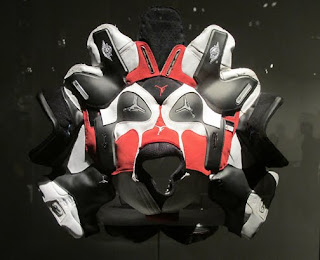With the unbelievable concentration of museums in Washington, D.C., you're bound to run across a surprise or two. On my cab ride to the National Botanic Garden, I noticed banners for an exhibit of Brian Jungen's work called Strange Comfort. It was showing at, of all places, the Smithsonian National Museum of the American Indian. While I enjoy historical and cultural museums, I'll almost always pass them up in favor of some good contemporary art. So it was a big surprise that the NMAI was featuring Jungen, who's a bit of darling in the art world right now. I quickly learned that the museum not only features the types of exhibits you'd expect, it also celebrates the art of living native Americans. (Although I had no Idea that Jungen qualifies as a Native artist but it does make sense and gives his work new meaning.)
Just this past year I've run across Jurgen's work twice. First, I saw one of his massive sculptures at the Vancouver Art Gallery during my trip to the 2010 Olympics. (Jungen lives and works in Vancouver.) Then this spring I saw one of his masks at the Flag Art Foundation. Since the NMAI is just across the street from the National Botanic Garden, I decided to pay a visit. I'm glad I did, because it was the favorite thing I saw in Washington.
Jungen is a master of taking the ordinary and making it magical. And he has an uncanny knack for cultural criticism; whether it's suggesting that our plastic, throw-away culture has consequences or pondering our cultural worship of the sports god.
Skull (2006-2009, baseballs, softballs) may not be about social criticism. But it sure is cool.
There were several carved plastic gas cans. This one is called White Death Camas (2007, carved five-gallon gasoline jug) and features a poisonous flower that can be found all over British Columbia. What an interesting juxtaposition of ideas and a strangely beautiful object.
People's Flag (2006, recycled textiles, natural and synthetic fibers) was created on site at London's Tate Modern. The flag was inspired by a 19th Century socialist anthem and more modern banners created by environmental groups like Greenpeace. This massive red work is mesmerizing.
Shapeshifter (2000, white polypropylene plastic chairs) is similar to the sculpture I saw in Vancouver. There is so much you can read into these works. There's the fact that whales were hunted to near extinction in the 19th Century for their oil. And today, oil of a different kind seems an equally hazardous threat to citizens of the ocean, a fact that is more ominous when you consider that this work is made of plastic, a substance manufactured largely from oil.
The Prince (2006, baseball gloves and dress form) is a little scary. Instead of commenting on the work, I offer this response from Jungen when asked why so much of his work features sports imagery: "Mainly because I've always been interested in sports. But I've also thought that if it's okay for North American sporting teams to use imagery and language and even some crude ceremonial practices of Native Americans, then I feel I have the right to use sports equipment. What sports fulfills in contemporary North America is this kinship ritual among fans. It's essentially a ceremony that's very specific and has rules and colors."
My favorite works in the show were these amazing totem poles. Each one is created as a remembrance of the past six decades of British Columbian history. For example, 1960 saw the Canadian Bill of Rights paving the way for Native voting rights. The Oka rebellion of 1990 was sparked by the expansion of a golf course on Mohawk lands. And in 2010 the Winter Olympics in Vancouver showcased native art and culture to an international audience. Here is an installation view of 1960, 1970, 1980 (all 2007, golf bags with golf balls and painted golf tees), and 1990 (2007, golf bags, cardboard tube).
And this is a detail from 2010 (2007, golf bags, cardboard tube).
I love shows that offer interesting facts about the culture I live in. For example, did you know that Michael Jordan was fined $5,000 every game he wore his Nike Air Jordans because the NBA didn't think the colors were appropriate? I learned that tidbit while looking at several of Jungen's ceremonial masks created from Air Jordans. Here are three of the masks which I can't accurately identify by title due to some sloppy note taking on my part.
I'm end with a bonus surprise from the NMAI. This is an object that wasn't created by Brian Jungen. I found it included on a wall of amazing beaded items. It's a meticulously beaded American flag titled Nations created by Jenny Ann "Chapoose" Taylor. It's constructed from 130,910 glass beads, leather, and nylon thread. If you look closely, you'll notice that words about our nation are carefully beaded into the flag. It's like a sparkling, shimmering Jasper Johns painting.













No comments:
Post a Comment